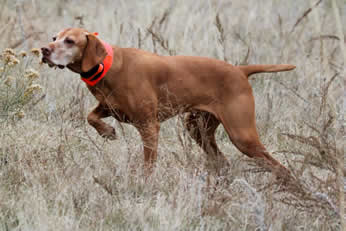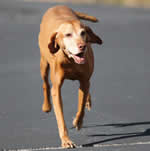Meet the magyar vizsla
This history of the Vizsla breed is from Marion Coffman’s, “In the Beginning”:How the Vizsla came to be
 The history of the Vizsla breed must first begin with the history of Hungary. Many different nomadic tribes roamed across Europe before crossing the Carpathian Mountains and settling in the year 895 on the land that was to be named Hungary. These nomads were descendants of Ugrians, Finns and Huns and brought with them their own hounds that may have been the ancestors of the early Vizsla. Primitive carvings in stone estimated to be 1,000 years old show these early Magyar hunters with their dogs closely resembling the Vizsla.
The history of the Vizsla breed must first begin with the history of Hungary. Many different nomadic tribes roamed across Europe before crossing the Carpathian Mountains and settling in the year 895 on the land that was to be named Hungary. These nomads were descendants of Ugrians, Finns and Huns and brought with them their own hounds that may have been the ancestors of the early Vizsla. Primitive carvings in stone estimated to be 1,000 years old show these early Magyar hunters with their dogs closely resembling the Vizsla.Settling down to lives of peaceful farming, horse breeding, cattle and pig raising, the Magyars needed to develop a breed of dogs related to the type of hunting these landowners pursued. The Magyar’s yellow hounds, which were brought from the areas where these nomads had wandered, were selectively bred until the hunters had dogs with specialized abilities. The breed they developed resembled each other in their acuteness of smell, a short muzzle, a pronounced stop and large floppy hound type ears.
Bird hunting was a necessity to provide food and these dogs were used to scent out game, and falcons were used to retrieve it. The dog’s quiet movement and deliberate action of pointing, plus their retrieving abilities that future breeding developed were very useful, especially after the use of firearms were invented.
In 1526, when the land was invaded by the Turks, the Magyar dogs were bred to the Turk’s yellow pointers and those from that union were called Vizsla which means SEEK in Turkish and POINT in Hungarian. The Vizsla obviously did both at that point.
Hungary was ruled by the Turks for the next 150 years but at the end of their occupation, when the German Hapsbugs ruled, the inheritance of the land was limited to the upper class. These were the people who played an important part in the early development of the Vizsla as we know it today. Shoots were organized and hunters from other countries brought the pointing dogs they had developed. These dogs were eventually crossed with the yellow-colored dogs of Hungary and were known by their versatility in the hunting of both birds and small game.
 Once the Hungarian hunters had developed the Vizsla into the type of dog they needed for their specific hunting areas, they kept it pure for many generations to come. Sportsmen from other countries still continued to cross breed to develop what they needed, and the Vizsla was bred to their Pointers and Irish Setters. It was not until 1882 that the Hungarian landowners realized they had very few dogs that were originally bred and called the Vizsla. Several generations later, after their supposedly use of the Schweizhund, a solid red hound with powerful abilities to scent, they did get the desired coat color for the Vizsla. They may have also used a pointer from Transylvania to reestablish the pointing ability. Whatever breeds were used, dedicated owners joined forces to keep the breed from extinction.
Once the Hungarian hunters had developed the Vizsla into the type of dog they needed for their specific hunting areas, they kept it pure for many generations to come. Sportsmen from other countries still continued to cross breed to develop what they needed, and the Vizsla was bred to their Pointers and Irish Setters. It was not until 1882 that the Hungarian landowners realized they had very few dogs that were originally bred and called the Vizsla. Several generations later, after their supposedly use of the Schweizhund, a solid red hound with powerful abilities to scent, they did get the desired coat color for the Vizsla. They may have also used a pointer from Transylvania to reestablish the pointing ability. Whatever breeds were used, dedicated owners joined forces to keep the breed from extinction.World War I and the land reform from the Hungarian Peace Treaty saw the Vizsla living on foreign soil, but determined Vizsla owners were dedicated to keeping the breed intact. In 1920, the Magyar Breeding Association was formed and started holding field trials and drew up a standard for the Vizsla breed. By 1941, World War II had started and it was to see many wealthy landowners flee Hungary for the safety of other countries. Many took their Vizslas with them but, before the war, 5,000 Vizsla had been registered in Hungary and, with the Soviet Invasion, there were at least 80% of the breed lost or destroyed. With registrations, pictures, and pedigrees lost during that time, new litters would be later registered as “of an unknown breeding” in the Hungarian stud books compiled in 1955.
 America was to see her first known Vizsla in 1950 after a man stationed in Italy sent a dam Sari, and her 2 pups Shasta and Tito, to a friend, Frank Tallman, in Kansas City. A few months later, Tallman sent to Europe again for another Vizsla, and this time Rex Del Gelsomino was sent from Italy. By 1951, other interested men arranged for the purchase and shipping of Vizslas from Austria and Germany. One of the top importers was Dr. Ivan Osborn who imported over 40 Vizslas and, along with other importers, bred extensively and campaigned for the breed. Dr. Osborn’s first import was from Czechoslovakia by the name of Broc Olca, and many of our Vizslas can trace their pedigrees back to him.
America was to see her first known Vizsla in 1950 after a man stationed in Italy sent a dam Sari, and her 2 pups Shasta and Tito, to a friend, Frank Tallman, in Kansas City. A few months later, Tallman sent to Europe again for another Vizsla, and this time Rex Del Gelsomino was sent from Italy. By 1951, other interested men arranged for the purchase and shipping of Vizslas from Austria and Germany. One of the top importers was Dr. Ivan Osborn who imported over 40 Vizslas and, along with other importers, bred extensively and campaigned for the breed. Dr. Osborn’s first import was from Czechoslovakia by the name of Broc Olca, and many of our Vizslas can trace their pedigrees back to him.Hungarian refugees were coming to America in large numbers, many of them bringing their Vizslas. There were a great number of litters born in America during the early days of importing Vizslas and, by 1953, the Magyar Vizsla Club of America was organized. By 1960, after the registration of 500 three-generation Vizslas, the AKC accepted the Vizsla breed into the Sporting Group. At that time, the club dropped the Magyar from their name and became the Vizsla Club of America. A new standard for the breed was approved in 1960 and revised in 1983, in 1996 and, most recently, in 2009. In the 50 years since AKC recognition, the Vizsla has gained a respected recognition of a versatile breed.
An all-a-round sporting dog, the Vizsla is adaptable in a variety of tasks and activities and competitions. The list of fun things to do with your Vizsla is endless. A wonderful companion in the home, field, conformation, obedience and agility, the Vizsla earned his place in AKC history by being the first of any breed to earn the Triple Champion title and the Quintuple Champion Title. Vizslas have been trained in every aspect of security at airports, drug detection, search and rescue, arson detection, and even mold detection. One of the most appreciated support is the work of the breed as therapy and service dogs. There is very little that the Vizsla is incapable of doing and is aptly named “versatile.” Certainly the Vizsla Breed has gone far since the early days of Hungarian history.
You can read another article about Vizslas and their history on "The Modern Dog" magazine's website. "The Vizsla - Hungarian Treasure."
Colorado Wyoming Vizsla Rescue Group, Inc. advocates copious amounts of research if you are considering purchasing or adopting a Vizsla. Vizslas are very special dogs that are sensitive, loving, and very much wanting to be a member of your family. "They need plenty of exercise (at least two hours per day) and thrive on games and stimulation. They are sometimes called the ‘Velcro Vizsla’ as they were bred to be close-ranging hunting dogs, never straying too far from their masters, but rather sticking close – like Velcro! Vizslas have been used as sniffer-dogs and security dogs with great success and they also make excellent pets for families. They like to stay in contact with their family, often following people from room to room, and becoming upset when left alone at home for long periods of time so do not get a Vizsla if the animal will be home alone for long hours every day." See article on the top 10 fastest breeds of dogs. Vizslas are listed as the second fastest breed, clocking in at 40 mph, Only the Greyhound is faster..
As such, we recommend reading about the breed so you have a better understanding of them.
There are many books available about Vizslas. Colorado Wyoming Vizsla Rescue Group, Inc. does not recommend any specific books, however a few of the books available are listed below. These books and many others can be found online at Amazon, Barnes and Noble, or other bookstores, both online or off the shelf.
“The Versatile Vizsla” by Marion Coffman
“The Complete Vizsla” by Gay Gottlieb
“Your Vizsla” by John X. Strauz
“The Hungarian Vizsla" by Gay Gottlie

